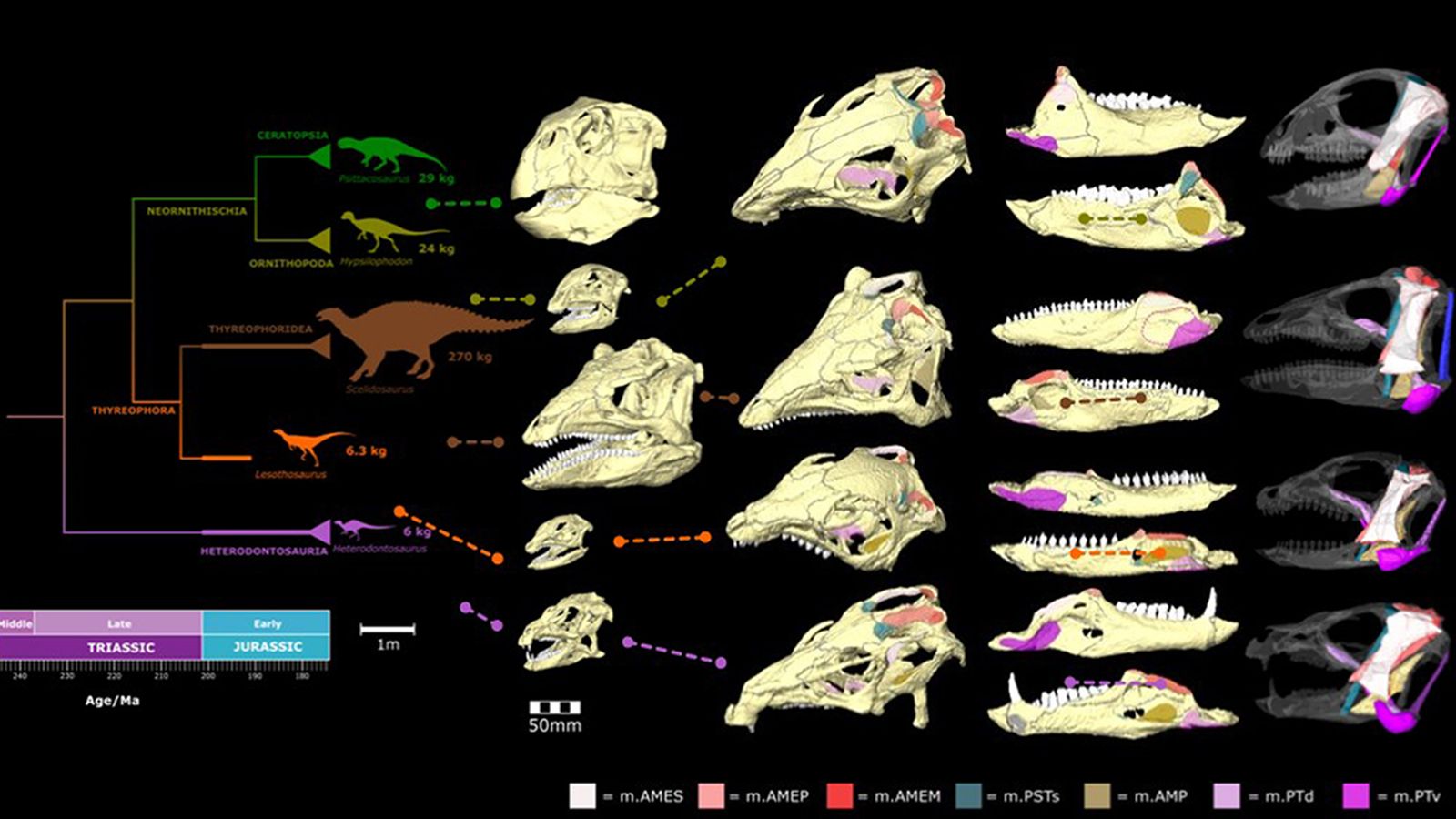‘Surprising variation’ in how plant-eating dinosaurs ate their food
In new research perfectly timed for Veganuary, dinosaur experts at London’s renowned Natural History Museum have discovered evidence that Jurassic-era herbivores had different ways of getting their veggies down.
Wednesday 4 January 2023 16:13, UK
EMBARGOED TO 1600 WEDNESDAY JANUARY 4 Undated handout graphic issued by Natural History Museum of some of the finite element models comparing bite performance across the five ornithischian dinosaurs in the study, with different models showing different bite points. (Cooler colours (bue) represent areas of low stress while hot colours (red and pink) indicate areas that are highly stressed.) Plant-eating dinosaurs may have evolved to have different ways of eating their food despite having a simila
Image:
The areas highlighted in pink showcase where the jaw is under greater stress while eating
Why you can trust Sky News
Plant-eating dinosaurs had a “surprising variation” in how they ate their food despite having a similar diet, research suggests.
By analysing skull specimens of herbivores such as the Jurassic-era Heterodontosaurus and Leothosaurus, British scientists determined that their eating styles changed based on their jaw muscles and biting actions.
Sponsored link
Recommended byWhat is Outbrain
It represents another sign of “how innovative and unpredictable evolution can be”, scientists said, as all plant-eating dinosaurs were already thought to have descended from a single carnivorous ancestor.
Senior study author Professor Paul Barret, a Natural History Museum palaeontologist, said: “If you want to understand how dinosaurs diversified into so many different types so effectively, it’s critical to learn how they evolved to feed on such a wide variety of vegetation in so many different ways.
“This diversity in feeding mechanisms set them up to dominate life on land for millions of years to come.”
The Heterodontosaurus and Leothosaurus skulls were studied alongside those of Scelidosaurus, Hypsilophodon, and Psittacosaurus – all of which belonged to a group of herbivorous creatures known as Ornithischia.
Researchers were then able to reconstruct the jaw muscles of the five dinosaur species and simulate their biting action, which suggested they had a different way of eating plants.
While Heterodontosaurus’s large jaw muscles relative to its skull size saw it produce a high bite force ideal for consuming tough vegetation, the Hypsilophodon had smaller muscles and rearranged them to bite more efficiently.
More dinosaur news:
Skeleton of 82ft dinosaur found in backyard
First record of dinosaur eating a mammal 120m years ago
EMBARGOED TO 1600 WEDNESDAY JANUARY 4 Undated handout graphic issued by Natural History Museum of CT reconstructions of the skulls and jaws together with diagrams of where the jaw muscles attach in each dinosaur. (The simplified family tree on the left shows how they are related to each other.) Plant-eating dinosaurs may have evolved to have different ways of eating their food despite having a similar diet, research suggests. An analysis of skull specimens by UK scientists indicates the first kn
Image:
This scan shows the reconstructions of the dinosaurs’ skulls, with jaws attached
Lead author Dr David Button said: “When we compared the functional performance of the skull and teeth of these plant-eating dinosaurs, we found significant differences in the relative sizes of the jaw muscles, bite forces and jaw strength between them.
“This showed that these dinosaurs, although looking somewhat similar, had evolved in very different ways to tackle a diet of plants.”
The findings were published in the journal Current Biology.






























